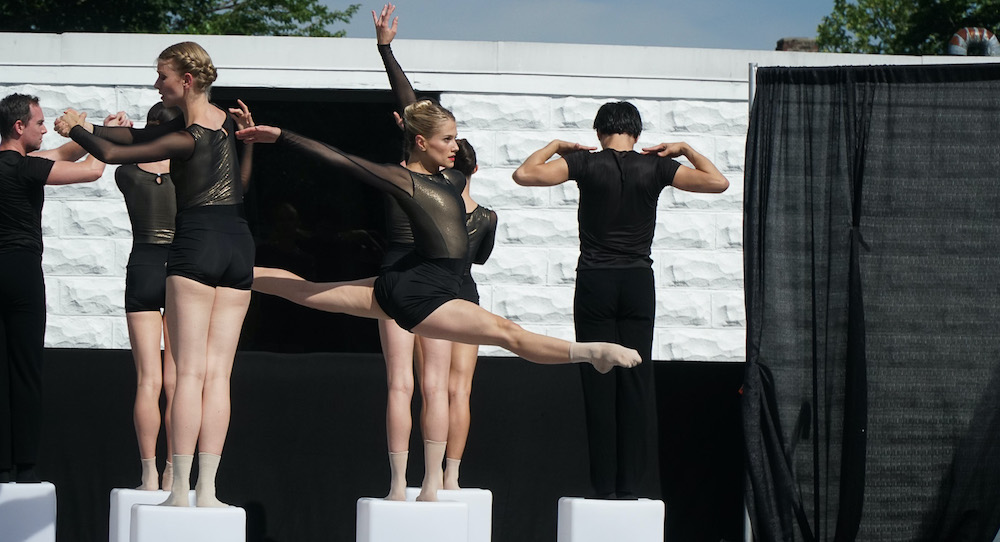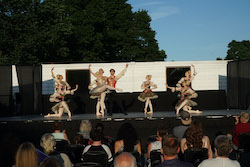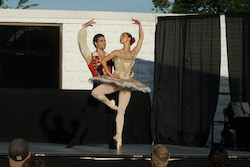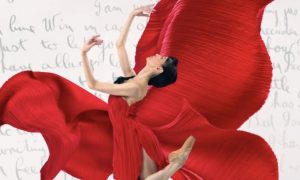The University Orthopedics Stage, Providence, RI.
June 18, 2021.
Live performances are popping up in locations all over the U.S., following adjusted CDC COVID guidance, allowing audience members and artists to once again be in community for the sake of live art. Sitting there waiting for Festival Ballet Providence’s return to the stage to start — its Emergence program — it felt strange but also comfortably familiar to be sitting in an audience prior to a performance, thumbing through the program and observing the scenery pre-set on the stage. Towering trees and the open sky were up above the outdoor stage and seating, the night a bit cloudy but also perfectly temperate.
Fellow audience members were jovial and friendly, reminding me of how live arts brings together communities of strangers — strangers for not too long. An announcer gave the typical welcome and request to turn off electronic devices, and my heart jumped with excited anticipation. The program to follow was bold and memorable, featuring premieres that demonstrated the versatility of the company’s artists as well as a strong spirit of collaboration. More classically-oriented works followed, illustrating the company’s commendable range of interests and capabilities.
Yury Yanowsky’s Same (2019) kicked off the program, a pleasantly enigmatic work of ingenuity and risk-taking — in both design and choreography. To begin, dancers in black robes stood in contrast to a dancer wearing golden earth-tone (costumes by Lyuba Yanowsky). The dancers in black placed white boxes to the side of the stage — another point of aesthetic opposition. A larger group joined, and they began to execute dynamic movement vocabulary: accented, angular, lifted overall but not afraid of low space and moving on and across the stage floor. Inventive gesture intrigued me, with the initiation of the hands and feet almost feeling as if the limbs had a will of their own.
I only wished the stage were larger; to me, it couldn’t quite hold the dancers’ collective energy and expansiveness. Alas, we do what we can in these unprecedented pandemic times. A second main group section, with movement a bit slower and more internal, translated better on the stage space as it was. An even later section was particularly pleasing and memorable, dancers making rhythms on the boxes and on their own bodies with perfect rhythm and unison. It made me ponder, for a moment, the inherent musical skill of elite dancers. As for the boxes, I wasn’t sure of any exact meaning they might signify, but they did pull me in and offer a lot of creative possibility.
Closing out the piece was an excellent duet from Charlotte Nash and Azamat Asangul: melty, serpentine and unpredictable. They tangled and untangled, continuously shifting shape. Courageous releases to gravity from Nash became imaginative lifts between the pair. Perhaps most memorable, however, was a slow shifting back and forth of weight from one foot to the other, Nash angling sideways in each direction with Asangul behind her.
This simple movement held so much beauty, and therein reminded me that the most pared-down movement can offer the most meaning and aesthetic potential. The score, by John Knowles, spoke of love remaining even as people holding that love change. As the dancers took their final bow, I thought about how this sort of ending on a duet or other smaller number of dancers isn’t as typical as ending with a large group. That was one choice amongst many that made the piece unique, vivid and mysterious.
An address from Director Kathleen Breen Combes did bring further concrete meaning — we’ve all changed from what’s happened over the past 16 months, yet we remain committed to coming together in love for art and in caring for one another. She also underscored the facility and physical prowess of the dancers even after not being able to perform on stages over the past year. I applauded their dedication and talent along with the rest of the audience; the first piece alone had made those things undeniable.
The world premiere of Strings, also by Yury Yanowsky, came next — a quartet to classical strings music (by Johann Sebastian Bach) that offered a pleasant and harmonious blend of contemporary and classical elements. It came right out with a virtuosic and attention-grabbing bang — including quickly shifting levels in space and a challenging turn — matching the allegro quality of the instrumental music right from the first notes. As the piece progressed and the three other dancers joined in the vigorous movement, clear and intentional movement qualities became clear; they moved with a classical base of strong lines yet also the contemporary qualities of releasing to gravity’s pressure and fresh, compelling gestures.
The dancers wore skin-toned leotards (matching their various skin tones), feeling like blank slates for movement and expression. In a neoclassical sense, they felt like embodiments of the music rather than individual characters. Even so, even just in just a canon phrase of a leap and an attitude turn, their separate movement signatures were wonderfully evident.
Even as they danced movement seemingly about the music, shape, and an impressive aesthetic, their individuality shining through it made it all the more satisfying. Even in their differences, the four dancers came together as a harmonious whole. Arguably, that’s the ideal with a group of dancers — and out there in the world.
The world premiere of ad infinitum followed that work, the first major concert piece from Festival Ballet Providence company member Eugenia Zinovieva. It’s a reflective and thought-provoking piece with movement and design elements illustrating that less can very much be more. The work also demonstrated the versatility of the company, with dancer Jay Markov composing the original score and dancer Emily Lovdahl designing the costumes. A soloist began moving to start the piece, moving in a silky, sinuous way.
Another soloist entered and began dancing, and the first soloist observed him move — beginning to instill the idea of watching ourselves and others. This idea of observation came back at later points in the work, adding further levels of meaning. These soloists repeated variations on the theme of discrete phrases of movement vocabulary. This instilled another idea that the choreography reinforced throughout the piece — that of repeating behaviors and ways of being, ad infinitum (“to infinity” or forever in Latin).
A larger group joined, and that sense of repeated movement continued — with new formations, qualities and alterations in the sequencing of movement keeping it all from becoming stale. Non-unison sections added compelling opposition, and sections seemingly improvised allowed dancers to move in ways most organic to their bodies. Overall, the movement felt more driven by inner sensation than by a desire to dance “big” or demonstrate any technical prowess. With many intriguing layers to peel away and enjoy, it demonstrated that movement doesn’t have to be showy to be strong and impressive.
Another intriguing touch was how in formations in a mid group section, dancers wearing two different costumes — pedestrian styling pleasantly colored and shaped — blended in two different groups. This choice reminded me that we don’t always fit nicely into discrete “camps” or “sides” of issues out there in the world — as nicely as we might think we do.
The dancers highly attuned to their own movement and their own bodies, and the choreography profoundly intentional, it all gave me pause to wonder what behaviors I repeat over and over that don’t serve me. What do others see about me that I don’t see? That’s meaningful food for thought.
The program took a more classical turn with a lovely pas de deux from Lady of the Camillas, a pleasing classical variation recontextualized to the modern in this rendition. Kirsten Evans, wearing a short white dress and a large white flower in her hair, danced with size and commitment but also precision and thoughtfulness of placement (without rigidity, which is key). Her partner, Alex Lantz, danced with similar qualities, making them an excellent team.
Closing out the program was the Wedding Suite from Don Quixote, a fun sequence of main and supporting characters taking turns dancing joyfully all across the stage. Zinovieva, choreographer of ad infinitum, danced Kitri — demonstrating a striking range of skills and interests.
In a program with a good amount of thought-provoking and mysterious work (and excellent work of that kind, to be sure), ending the program on a note of simple joy and beauty felt like a great choice. Brava to Festival Ballet for this bold and thoroughly satisfying return to live stage performances — with a wide range of styles, collaborations and versatile contributions, and the courage to take creative risks.
By Kathryn Boland of Dance Informa.

















